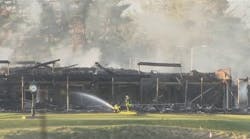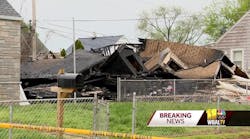To begin to examine the state of live-fire training, we'll review the move by some fire departments away from conducting live-fire training due to its perceived low value and high risks. Is the fire service making a wrong turn?
Let us start with important data. First, according to statistics compiled by the National Fire Protection Association (NFPA), the overall number of structure fires in the United States is declining. In most areas, firefighters are working at fewer fires today and have less experience compared to their predecessors of a generation ago. At the same time, while the overall firefighter fatality rate remains virtually unchanged, there is an increase in the number of firefighters being killed and injured inside structures during extinguishment activities. So, at a time when fire personnel generally have less fire experience and firefighter fatalities are increasing inside structure fires, why are some in the fire service moving away from live-fire training? More specifically, why move away from using acquired structures for live-fire training when it seems we need high-quality, effective live-fire training today more than ever before?
With recent events, including the tragic death of a recruit firefighter during a live-fire training session, there is quite a bit of discussion on the apparatus room floor about the pros and cons of live-fire training. Every so often, I hear statements about live-fire training that I don't buy into. Here is one of them: "Live-fire training in acquired structures is just too dangerous. I won't take that sort of risk in my district."
What's true about this statement is that live-fire training can be dangerous. If NFPA 1403, Live Fire Training Evolutions, is not followed by competent instructional personnel and good industry live-fire training practices are not used, bad things can happen. As an analogy, driving a car through a residential neighborhood at 85 mph and not wearing a seatbelt is dangerous. Likewise, fire officers performing live-fire training in acquired structures without qualified instructors, with inappropriate structure preparation and non-compliance with NFPA 1403 can lead to dangerous situations. But live-fire training does not have to be dangerous. By using NFPA 1403 and following good industry practices, hazards can be identified, removed, mitigated or managed. By appropriate planning and action, a potentially hazardous condition or situation can be avoided and training conditions turned into an acceptable, calculated risk.
Even with full NFPA 1403 compliance, there is still a minimal level of risk for firefighters during live-fire training. However, it is a calculated and acceptable risk for most fire officers. To step back a moment and use the speeding-car analogy, if we drive that same car but now slow it down from 85 to 25 mph and fasten our seatbelt, our risk of death would be significantly reduced (as well as the risk to the neighborhood kids). However, the risk is not entirely eliminated. Similarly, when we comply with NFPA 1403 and use good fire industry practices during live-fire training in acquired structures, we can significantly reduce injury and fatality risks to a manageable, acceptable level.
Fire officers are fire service risk managers. We all should agree that approaching live-fire training in any less of a fashion than that called out in NFPA 1403 could be considered proceeding with reckless abandon, which can be costly in regard to potential firefighter injuries and deaths. Turning the tables, those fire officers who steer away from conducting effective live-fire training altogether have yet another risk on their hands — under-trained firefighters who pose risks to themselves and others. Firefighter training is a "pay me now or pay me later" type of program.
"Pay me know or pay me later" means either taking the calculated risks of performing live-fire training in compliance with NFPA 1403 now or bearing the risks later during real-world fire responses where under-trained firefighters may not be able to recognize destructive fire behavior and structural collapse, and thus not be able to react in time to save themselves and others.Another statement that I just don't buy into:
"We have a new reusable structural burn building that features natural gas props. That type of training is good enough for our people."
It is great to have a quality burn building and to be able to perform basic and essential training evolutions. This allows basic skills and knowledge training to take place in a minimized risk environment. This is a critical part of the firefighter training and education pyramid. Today's reusable burn building design and construction are more realistic than ever before. That's great for teaching firefighters how to conduct certain tasks in an environment that comes close, but does not replicate a real fire environment. Realistically, though, if we allow firefighters' mental impressions of what to expect at a real-world structure fire to become the same as what he or she sees in a reusable burn building with a gas-powered prop, we could be in for a world of trouble.
This was personally driven home to me during a training exercise — there can be a big disconnect between how firefighters believe fire will behave and what actually happens in a real-world fire scenario after their training impressions from observing gas-powered props in a reusable burn building. This was an experience with a student during an evolution where I was the attack team instructor during a live-fire training session in an acquired structure. This was a NFPA 1403-compliant training session with a large combination fire department. The dwelling, from side A, was single-story with a basement, but the basement was exposed on side C with a walkout doorway at ground level.
The specific evolution I'm talking about was a kitchen fire, with advancement of a charged hoseline in the basement door, up the center basement stairs to the first floor and about 10 more feet to the doorway of a kitchen. We climbed the basement stairs; I opened the basement door and had the team begin to advance toward the kitchen. I was caught flat-footed for a second at the top of the stairs as the nozzleman ended up making, by his own volition, a "mad-dash" for the kitchen. I acted quickly to catch up. I grabbed him as he was about to enter the kitchen, which was clearly well involved and untenable. I held him at the doorway while ordering the hoseline opened.
After the fire attack took place and overhaul was conducted, I pondered why any firefighter would have an instinct to enter a room that was entering a phase of combustion that was clearly life threatening. It seemed that the only firefighting experience that this young career firefighter had was in a reusable burn building, where there were no flashovers, only rollover of flames via gas-powered fire simulator props. He was just providing the same actions he had done a number of times before in a reusable burn building.
We, as instructors, have to be very careful about both the impressions and behaviors we drill into our students' minds. At its simplest, we need to train people as we expect them to act during the real deal. In the specific live-fire training scenario above, we were able to critique the actions that occurred during the evolution and bring about student learning — a go-forward change in this student's behavior. But had this firefighter been involved in a real-world fire response, faced with this same scenario, and had he done the same thing, he would have made the mistake of entering a room just about to flash over, leading to injury or worse. For his sake, during that live-fire training session in an acquired structure, he had an attack team instructor and an interior safety officer looking out for everyone's welfare — the NFPA 1403 safety system worked as designed.
The issue here is not the gas-powered prop or reusable burn building versus an acquired structure. The issue is about how we use our props and what we are teaching students in live-fire training. It is also about driving student behavior by training impressions and the outcome of placing those training impressions to use in the real world. If you are a training officer and not able to train in acquired structures, what are you teaching students about fire behavior, fire attack and structural collapse?
What is happening with live-fire training in your fire district? Please send me an e-mail at [email protected] to discuss the issues you are dealing with and your views on using acquired structures for live-fire training.
DOMINIC COLLETTI is the author of The Compressed Air Foam Systems Handbook and Class A Foam—Best Practice For Structure Firefighters. He is co-author of Foam Firefighting Operations 1 and The Rural Firefighting Handbook. Colletti is a former assistant fire chief and serves on the technical committee of NFPA 1500 Fire Department Occupation Safety and Health Program. He is the Global Foam Systems Product Manager for Hale Products and can be reached at [email protected].





